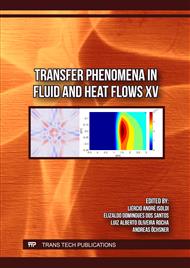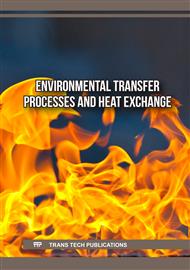[1]
X. Stavropulos-Laffaille, K. Chancibault, H. Andrieu, A. Lemonsu, I. Calmet, P. Keravec, V. Masson, Coupling detailed urban energy and water budgets with TEB-Hydro model: Towards an assessment tool for nature based solution performances, Urban Climate, 39 (2021), 100925.
DOI: 10.1016/j.uclim.2021.100925
Google Scholar
[2]
A.M.M. Irfeey, H.W. Chau, M.M.F. Sumaiya, C.Y. Wai, N. Muttil, E. Jamei, Sustainable mitigation strategies for urban heat island effects in urban areas. Sustainability, 15 (2023), 10767.
DOI: 10.3390/su151410767
Google Scholar
[3]
V. Ranieri, S. Coropulis, N. Berloco, V. Fedele, P. Intini, C. Laricchia, P. Colonna, The effect of different road pavement typologies on urban heat island: A case study. Sustainable and Resilient Infrastructure, 7(6) (2022), 803-822.
DOI: 10.1080/23789689.2022.2067951
Google Scholar
[4]
E.C. Thom, The discomfort index, Weatherwise, 12(2) (1959), 57-61.
Google Scholar
[5]
M.N. Mistry, A high spatiotemporal resolution global gridded dataset of historical human discomfort indices. Atmosphere, 11(8) (2020), 835.
DOI: 10.3390/atmos11080835
Google Scholar
[6]
Information on https://portal.inmet.gov.br/normais.
Google Scholar
[7]
M.C.C.T. Amorim, Ilhas de calor urbanas: métodos e técnicas de análise. RBCLima, 25 (2019), 22-46.
DOI: 10.5380/abclima.v0i0.65136
Google Scholar
[8]
G. Molnár, A. Kovács, T. Gal, How does anthropogenic heating affect the thermal environment in a medium-sized Central European city? A case study in Szeged, Hungary. Urban Climate, 34 (2020), 100673.
DOI: 10.1016/j.uclim.2020.100673
Google Scholar
[9]
H. Li, Y. Zhou, X. Wang, X. Zhou, H. Zhang, S. Sodoudi. Quantifying urban heat island intensity and its physical mechanism using WRF/UCM. STOTEN, 650 (2019), 3110-3119.
DOI: 10.1016/j.scitotenv.2018.10.025
Google Scholar
[10]
H. Takebayashi, M. Senoo, Analysis of the relationship between urban size and heat island intensity using WRF model. Urban climate 24 (2018), 287-298.
DOI: 10.1016/j.uclim.2016.12.003
Google Scholar
[11]
R.S.B. Sales, D.S. Sales, J.C. Mendonça, Balanço de energia e ilhas de calor no perímetro urbano de Campos dos Goytacazes, RJ: Um estudo de caso. RBGF, 15(06) (2022), 3093-3105.
DOI: 10.26848/rbgf.v15.6.p3093-3105
Google Scholar
[12]
Information on https://portal.inmet.gov.br/dadoshistoricos.
Google Scholar
[13]
D. Li, E. Bou-Zeid, Quality and sensitivity of high-resolution numerical simulation of urban heat islands. ERL, 9(5) (2014), 055001.
DOI: 10.1088/1748-9326/9/5/055001
Google Scholar
[14]
Information on http://www2.mmm.ucar.edu/wrf/users/download/get_sources_wps_geog.html.
Google Scholar
[15]
National Centers for Environmental Prediction/National Weather Service/NOAA/U.S. Department of Commerce. 2015, updated daily. NCEP GFS 0.25 Degree Global Forecast Grids Historical Archive. Research Data Archive at the National Center for Atmospheric Research, CISL.
Google Scholar
[16]
D.S. Sales, J. Lugon Jr., V.D.P.S. Oliveira, N.S. Ferreira, A.J. Silva Neto, Sensitivity analysis of atmospheric phenomena models for precipitation assessment on the Paraíba do Sul River watershed. CeN, 44, 2022, e55-e55.
DOI: 10.5902/2179460x66757
Google Scholar
[17]
D.S. Sales, J. Lugon Jr., V.D.P.S. Oliveira, A.J. Silva Neto, Rainfall input from WRF-ARW atmospheric model coupled with MOHID land hydrological model for flow Simulation in the Paraíba do Sul River-Brazil. JUEE, 15(2), 2021.
Google Scholar
[18]
W.C. Skamarock, J.B. Klemp, J. Dudhia, D.O. Gill, Z. Liu, J. Berner, X.Y. Huang, A description of the advanced research WRF version 4. NCAR tech. note ncar/tn-556 (2019), 145.
Google Scholar
[19]
H. Kusaka, H. Kondo, Y. Kikegawa, F. Kimura, A simple single-layer urban canopy model for atmospheric models: Comparison with multi-layer and slab models. Boundary-layer meteorology 101 (2001), 329-358.
DOI: 10.1023/a:1019207923078
Google Scholar
[20]
D. Li, E. Bou-Zeid, Quality and sensitivity of high-resolution numerical simulation of urban heat islands. ERL, 9(5) (2014), 055001.
DOI: 10.1088/1748-9326/9/5/055001
Google Scholar
[21]
J.C. Teixeira, J. Fallmann, A.C. Carvalho, A. Rocha, Surface to boundary layer coupling in the urban area of Lisbon comparing different urban canopy models in WRF. Urban Climate, 28 (2019), 100454.
DOI: 10.1016/j.uclim.2019.100454
Google Scholar
[22]
A. Sharma, P. Conry, H.J.S. Fernando, A.F. Hamlet, J.J. Hellmann, F. Chen, Green and cool roofs to mitigate urban heat island effects in the Chicago metropolitan area: Evaluation with a regional climate model. ERL, 11(6) (2016), 064004.
DOI: 10.1088/1748-9326/11/6/064004
Google Scholar
[23]
D.K. Papanastasiou, D. Melas, H.D. Kambezidis, Air quality and thermal comfort levels under extreme hot weather. Atmospheric Research, 152 (2015), 4-13.
DOI: 10.1016/j.atmosres.2014.06.002
Google Scholar
[24]
H.M. Imran, J. Kala, A.W.M. Ng, S. Muthukumaran, An evaluation of the performance of a WRF multi-physics ensemble for heatwave events over the city of Melbourne in southeast Australia. Climate Dynamics, 50 (2018), 2553-2586.
DOI: 10.1007/s00382-017-3758-y
Google Scholar
[25]
A. Rocha, R. Silva, Estudo e Cartografia da Ilha de Calor Urbano para o Clima futuro – Fase 3. Lisboa: Instituto do Ambiente e Desenvolvimento – IDAD (2019), 60 p.
Google Scholar
[26]
S. Lokesh, N. Kadiwal, R. Chandrashekar, A. Pai, B. Kumar, Heat transfer study of green roof in warm and humid climatic conditions. Materials Today: Proceedings (2023).
DOI: 10.1016/j.matpr.2023.05.010
Google Scholar
[27]
G. Swamy, S.S. Nagendra, U. Schlink, Urban heat island (UHI) influence on secondary pollutant formation in a tropical humid environment. JA&WMA, 67(10) (2017), 1080-1091.
DOI: 10.1080/10962247.2017.1325417
Google Scholar
[28]
I.D. Stewart, E.S. Krayenhoff, J.A. Voogt, J.A. Lachapelle, M.A. Allen, A.M. Broadbent, Time evolution of the surface urban heat island. Earth's Future, 9(10) (2021), e2021EF002178.
DOI: 10.1029/2021ef002178
Google Scholar
[29]
S.E.C. Pitton, O comportamento térmico da cidade de Rio Claro (SP):contribuição ao estudo do clima urbano das cidades tropicais. In: Éncontro de Geógrafos da América Latina, 1991, Toluca -México. Memorial do Encontro de Geógrafos da América Latina. v. II. (1991), pp.327-337.
DOI: 10.54446/bcg.v13i1.3181
Google Scholar
[30]
A. Rasul, H. Balzter, C. Smith, J. Remedios, B. Adamu, J.A. Sobrino, M. Srivanit, Q. Weng, A review on remote sensing of urban heat and cool islands. Land, 6(2) (2017), 38.
DOI: 10.3390/land6020038
Google Scholar
[31]
V.S. Marques, R. André, E. Sucharov, F. Pinheiro, Possíveis modificações na classificação climática das regiões norte e noroeste do Estado do Rio de Janeiro. Sistema de Meteorologia do Estado do Rio de Janeiro-SIMERJ (2002).
DOI: 10.21840/siic/159625
Google Scholar
[32]
F.G. Teixeira, A.F. Leite, Formação de ilhas de calor noturnas na estação de inverno no município de Campos dos Goytacazes (RJ), Confict (2018).
Google Scholar



